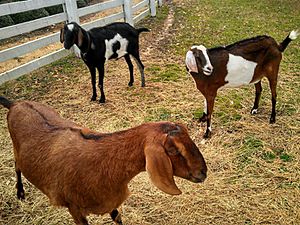Historic Oak View facts for kids
Quick facts for kids |
|
|
Oak View
|
|

1855 Historic Greek Revival Farmhouse
|
|
| Location | Jct. of Poole Rd. and Raleigh Beltline, Raleigh, North Carolina |
|---|---|
| Area | 15 acres (6.1 ha) |
| Built | c. 1855 |
| Architectural style | Greek Revival, Colonial Revival |
| NRHP reference No. | 91000359 |
| Added to NRHP | April 3, 1991 |
Historic Oak View is a special old farm in Raleigh, North Carolina. It's also known as the Williams-Wyatt-Poole Farm. This farm has a long history, starting in the 1800s. Many people, including those forced to work without pay, helped build and run this farm.
Today, Oak View is a historic site where you can learn about farming in North Carolina. You can see an old kitchen, an 1855 farmhouse, a barn for animals, and a cotton gin barn. There's also a tenant house from the early 1900s. The Farm History Center teaches visitors all about the farm's past. You can also explore an orchard, a honey bee hive, a small cotton field, and the biggest pecan grove in Wake County.
Contents
The Story of Oak View Farm
How the Farm Began
The story of Historic Oak View started in 1829. A man named Benton Southworth Donaldson Williams bought 85 acres of land in Wake County. He paid $135 for it. Over the next 30 years, Williams bought more land. This included the spot where Oak View's oldest building, the kitchen, now stands. In 1855, Williams finished building the main farmhouse. It was a two-story house built in the Greek Revival style. This house became the heart of the farm for many years.
Farming Life Before the Civil War
By 1860, before the American Civil War, the Williams family had 10 people working on the farm who were forced to labor without pay. They grew a lot of Cotton, producing 27 bales each year. Cotton was a very important crop in the Southern United States. After the Civil War, many farmers, including the Williams family, grew even more cotton. By the 1880s, most farms in Wake County, including Oak View, grew cotton. The Williams family was growing 82 bales a year!
After the Civil War, Benton Williams helped shape North Carolina's future. He was chosen to represent Wake County at an important meeting in 1868. This meeting helped decide how North Carolina would rebuild after the war. Williams had supported the Union during the war, which was not popular in Raleigh. But his connection to Governor Holden helped him play a role in the Reconstruction Era. Oak View is the only home of those Wake County delegates that is still standing today.
The Wyatt Family Takes Over
Benton Williams passed away in 1870. His land was divided among his children and his wife, Burchett. After Burchett died in 1886, the farm was sold. Job P. Wyatt bought the land, house, and other buildings. His family ran the farm for almost 60 years. Many of the buildings you see at Oak View today, like the cotton gin house and the livestock barn, were built when the Wyatt family owned the farm.
The Wyatt family often hired a manager to run the farm day-to-day. Instead of sharecroppers, they had tenant farmers who lived in small houses on the property. These farmers grew crops for the Wyatts and also for themselves, earning a wage. Some tenant families stayed for only a year, but tenant farmers lived at Oak View until the 1980s. Even though the Williams family had success, the Wyatt family often struggled to make a profit. They started using Oak View to test seeds for their seed company in Raleigh. They began growing vegetables and pecans instead of mostly cotton. The pecan orchard they planted still produces pecans every year and is the largest in Wake County.
New Owners and a New Purpose
Later, the Wyatt family traded Oak View to the Gregory-Poole family. The Pooles wanted a downtown office for their seed company. James Gregory Poole and his family moved into the farmhouse. They lived there for three years and made many updates. They added to the house, put in running water, and brought electricity to the farm for the first time.
After these changes, the Poole family sold the farm to James and Mary Bryan in 1944. The Poole family's additions were the last big changes to the historic buildings. The property changed hands a few more times. In 1984, Wake County bought the farm. The county first planned to tear down the buildings to build offices. But many local families and descendants worked together to save the property. In 1991, Historic Oak View was added to the National Register of Historic Places. Soon after, it became a Wake County park.
Oak View Today

In 1995, the Wake County Parks, Recreation and Open Space Division took over managing Oak View. It became the first historic site in the Wake County park system. In 1997, the Farm History Center opened. Since then, Oak View has focused on teaching people about North Carolina's farming history. This includes everything from early colonial times to today.
Recently, a historic tenant house was moved to the park. This helps visitors learn about the lives of the people who lived and worked on the Oak View land. Today, more than 100,000 people visit Oak View each year. They come to learn about North Carolina's farming past through fun programs, events, and exhibits.



